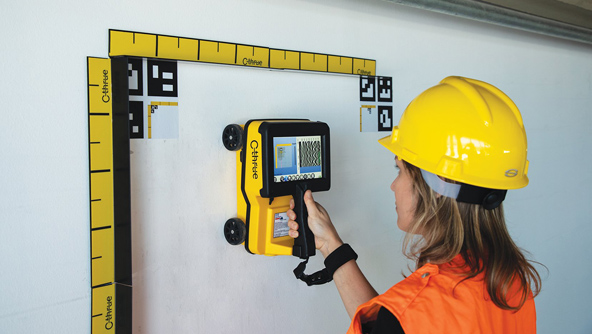Elevate Your Building And Construction Process With the Strategic Insights of Concrete Scanning for Improved Productivity
In the realm of contemporary building practices, the pursuit for efficiency and precision is extremely important. Embracing ingenious technologies has actually come to be a keystone for attaining these goals. One such innovation that has revolutionized the building and construction industry is concrete scanning. By using the strategic understandings given by concrete scanning, building experts can unlock a realm of boosted performance and structured procedures. The effects of incorporating concrete scanning go far past surface-level advantages, offering an extensive influence on task results.

Benefits of Concrete Scanning
Enhancing project performance and safety, concrete scanning provides a non-destructive technique for identifying concealed objects within concrete frameworks. By using modern technologies such as ground-penetrating radar (GPR) and concrete x-ray imaging, building and construction teams can accurately locate rebar, post-tension cables, electric channels, and other blockages prior to boring, cutting, or coring right into concrete.
The benefits of concrete scanning are various. Firstly, it lessens the danger of unintentional damages to critical architectural aspects, minimizing the likelihood of pricey repair services and job delays. It improves employee safety and security by offering real-time understandings right into the location of covert threats - Concrete Scanning. Building websites can be complex settings, and understanding what exists below the surface can avoid accidents and injuries.
Additionally, concrete scanning advertises total job performance by streamlining workflows and preventing rework. By recognizing potential problems at an early stage, groups can adjust their strategies proactively, conserving time and sources over time. Fundamentally, the fostering of concrete scanning modern technologies is a calculated financial investment that pays rewards in regards to productivity, cost-effectiveness, and safety and security.
Modern Technology Integration for Performance
Concrete scanning's capability to improve operations and boost job effectiveness can be more enhanced via critical integration of cutting-edge technologies. By integrating Building Information Modeling (BIM) software program into concrete scanning processes, building and construction teams can achieve a greater degree of precision and coordination. BIM permits the creation of 3D designs that supply thorough understandings into the job, allowing much better decision-making and lowering the probability of errors. In addition, the combination of Enhanced Fact (AR) innovation with concrete scanning can improve on-site visualization, allowing project managers and workers to overlay electronic info onto the physical setting in genuine time. This can assist in more accurate positioning of aspects and enhance communication amongst staff member. The usage of drones for aerial surveys in conjunction with concrete scanning can speed up data collection and analysis, allowing quicker decision-making and progression monitoring. Generally, the strategic integration of these technologies can considerably boost efficiency and efficiency in building tasks.
Staying Clear Of Pricey Mistakes
Just how can meticulous focus to detail throughout concrete scanning processes aid construction groups in preventing pricey mistakes? By using advanced scanning modern technologies such as Ground Passing Through Radar (GPR) and over at this website electro-magnetic induction, building groups can properly discover rebar, energies, gaps, and various other blockages within concrete frameworks. In addition, concrete scanning assists in making sure architectural honesty by identifying weaknesses or defects in the concrete very early on, permitting for timely repair services and alterations.
Enhancing Task Monitoring
Precise interest to information throughout concrete scanning processes not only aids in preventing expensive errors but additionally lays a solid structure for reliable task monitoring in building and construction endeavors. By including concrete scanning modern technology right into project administration strategies, construction teams can streamline process, improve interaction, and make sure that projects stay on track.
Concrete scanning offers important understandings right into the architectural stability of existing components, enabling task managers to make enlightened decisions regarding style adjustments or construction series. This proactive method decreases the danger of unanticipated hold-ups or revamp, eventually conserving time and sources. In addition, the data obtained from concrete scanning can be integrated into Structure Details Modeling (BIM) systems, making it possible for real-time cooperation and coordination among numerous stakeholders.
In addition, concrete scanning aids project supervisors identify possible threats or barriers prior to they escalate right into larger problems, promoting a more secure workplace for all entailed. With boosted see post presence and accuracy given by concrete scanning technology, task managers can properly intend, keep track of, and execute building tasks with greater efficiency and self-confidence.
Maximizing Performance
One key aspect of optimizing productivity is with the adoption of concrete scanning innovation. By utilizing ground-penetrating radar (GPR) and various other scanning methods, building and construction groups can accurately locate rebar, channels, and other subsurface components, decreasing the danger of costly errors and delays throughout excavation and boring.
Moreover, accepting Building Info Modeling (BIM) software program can dramatically improve productivity by producing detailed 3D models that improve task visualization and control among various professions. BIM permits much better clash discovery, enabling concerns to be determined and resolved prior to building and construction even begins, saving time and resources in the long run.
Carrying out a lean construction method, which focuses on removing waste and maximizing performance throughout all task stages, is another effective approach for optimizing efficiency. By promoting partnership, interaction, and continuous enhancement, building groups can function much more cohesively in the direction of attaining task goals in a effective and structured manner.
Verdict
Finally, the critical application of concrete scanning in the building and construction procedure uses many advantages, consisting of boosted efficiency, expense financial savings, boosted project administration, and enhanced performance. By incorporating this innovation, construction teams can avoid pricey errors, enhance their procedures, and maximize their overall job output. Concrete scanning is a useful tool that can raise the building and construction procedure and bring about even more effective and rewarding outcomes.
